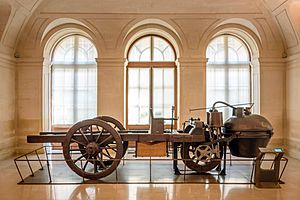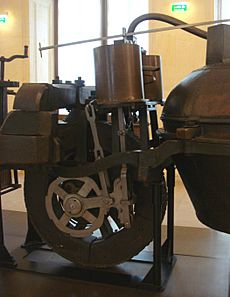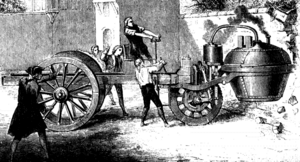Nicolas-Joseph Cugnot facts for kids
Quick facts for kids
Nicolas-Joseph Cugnot
|
|
|---|---|
| Born | 26 February 1725 Void-Vacon, Lorraine
|
| Died | 2 October 1804 (aged 79) |
| Nationality | French |
| Occupation | Engineer |
| Children | 2 children |
| Engineering career | |
| Projects | fardier à vapeur |
Nicolas-Joseph Cugnot was a French inventor. He is famous for building the very first self-moving vehicle. This vehicle was the world's first true automobile! He was born on February 26, 1725, and passed away on October 2, 1804.
Contents
Early Life and Engineering
Nicolas-Joseph Cugnot was born in Void-Vacon, a place in Lorraine, France. Today, this area is known as the Meuse department. He studied to become a military engineer. In 1765, he started working on steam-powered vehicles. The French Army wanted these vehicles to move heavy cannons.
Cugnot's Steam Vehicle
Captain Cugnot was one of the first to successfully use a steam engine to make a wheel turn. He used a special part called a ratchet to do this.
The First Fardier à Vapeur
In 1769, Cugnot built a small, three-wheeled vehicle. He called it a fardier à vapeur, which means "steam dray." A fardier was a very strong cart pulled by horses. It was used to carry heavy things like cannons. Cugnot's steam version was meant to do the same job.
Building a Full-Size Model
In 1770, a larger version of the fardier à vapeur was built. It was designed to carry four tons of weight. It was also supposed to travel about 7.8 kilometers (4.8 miles) in one hour. However, it never reached this speed in real tests.
The vehicle itself weighed about 2.5 tons. It had two wheels at the back and one large wheel at the front. The front wheel held the steam boiler and the engine. The engine part could turn separately from the back part. This allowed the driver to steer it using a double handle. Some reports say it could carry four passengers. It moved at a speed of about 3.6 kilometers per hour (2.25 miles per hour).
Challenges and Problems
The fardier had some big problems. It was very unstable because its weight was not spread out well. This made it hard to drive, especially on rough ground or up hills.
The steam engine also had issues. The boiler did not work very well. The fire had to be relit, and steam had to be built up again, every 15 minutes or so. This made the vehicle very slow and limited how far it could go.
Project Abandoned and Preserved
After a few test runs, the project was stopped. These tests took place between Paris and Vincennes, and also at Meudon. This was the French Army's first attempt at using mechanical vehicles.
Even though the project ended, King Louis XV still recognized Cugnot's hard work. In 1772, the King gave Cugnot a yearly payment for his new ideas. The fardier was kept at the arsenal because it was considered important. In 1800, it was moved to the Conservatoire national des arts et métiers museum in Paris. You can still see it there today!
Modern Replica
In 2010, over 240 years later, a copy of the fardier de Cugnot was built. Students from a French engineering school, Arts et Métiers ParisTech, helped build it. The city of Void-Vacon also helped.
This new replica worked perfectly. It showed that Cugnot's original idea was indeed possible! This replica was shown at the 2010 Paris Motor Show. Now, it is displayed in Cugnot's hometown of Void-Vacon.
The First Reported Car Accident
There are stories about a small accident in 1771. It is said that the second fardier prototype accidentally crashed into a brick or stone wall. This might have been in a Paris garden or part of the Paris Arsenal walls. If true, this would be the first known car accident in history!
However, this incident was not written down at the time. The story first appeared in 1804, 33 years after it supposedly happened. Still, the story continues that Cugnot was even arrested for dangerous driving. If this is true, it would be another "first" for him!
Later Years
After the French Revolution began in 1789, Cugnot's yearly payment was stopped. He then moved to Brussels, where he lived in poverty.
But before he passed away, his payment was given back to him by Napoleon Bonaparte. Cugnot then returned to Paris. He died there on October 2, 1804.
See also
 In Spanish: Nicolas-Joseph Cugnot para niños
In Spanish: Nicolas-Joseph Cugnot para niños





